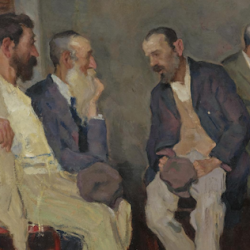In his recent study of John of Damascus, Perichoresis and Personhood, Charles Twombly expresses concern that contemporary theologians use traditional concepts and formulae “in a manner that betrays little understanding of how they actually developed.” By attending to the way John uses the term, we can “lay claim to a truer and stronger sense of its character in the context of classical doctrine” (3-4).
John uses the term to express certain kinds of relationships, specifically the relation “of three ‘persons’ . . . connected to each other in a common ‘substance’” and the relation of two natures in the one Person of Christ. In soteriology, the relationship is between “the baptized believer” and “the sanctified humanity of Christ.” Though the participation involved in theosis overlaps with perichoresis, it is not identical to it (5). Because the relationship of human beings to God is a matter of partial, halting faith, and hence a relationship in flux, John avoids the language of perichoresis to describe it, instead talking about communion and participation.
In all of these relationships, John is struggling to express identity and difference, and in certain contexts perichoresis provides a useful way to express it. Twombly notes that in using perichoresis, the tradition was taking up a traditional term and giving it a good stretch so that it could “embrace a reality sensed but never adequately articulated.” In this respect, perichoresis is like other terms taken up into Trinitarian theology – hypostasis and ousia were not the same after the Cappadocians got ahold of them (6).
But here some lose track of the argument. If the fathers stretched terms to gather up new insights, why can’t we? To read some Trinitarian theologians, the stretching stopped around the fifth century, and now we are faithful to the fathers not by imitating their stretching exercises but by using the terms they used in precisely the same way they used them.
Twombly strikes a nice balance. He doesn’t think that “John’s own usages preclude . . . expansion,” but he stresses caution and wants to make clear why John used perichoresis in the contexts that he did. Yet he ends with an acknowledgement that John deployed the concept in ways that “reveal creative advances in what might appear as wider territory and thereby provide a warrant for us to do likewise.” He cites John’s defense of icons, and notes, “In our day, perhaps there are those who grasp the depth of perichoresis in terms of the classical Christian doctrines and go on to probe its implications for enlarged areas of theological interest” (106).
(Since “perichoresis” isn’t used in Scripture, it’s neither here nor there whether we restrict its use to the relations of the Triune Persons and the natures of Christ, or whether we expand it to describe human beings in union with God. Whatever terms we might use, whatever distinctions we must make, the fact remains that there is an analogy between the “I in You/You in Me” of the Father and Son, and the “in Christ/Christ in you,” “in Spirit/Spirit in you” relation of believers to the Triune God.)












